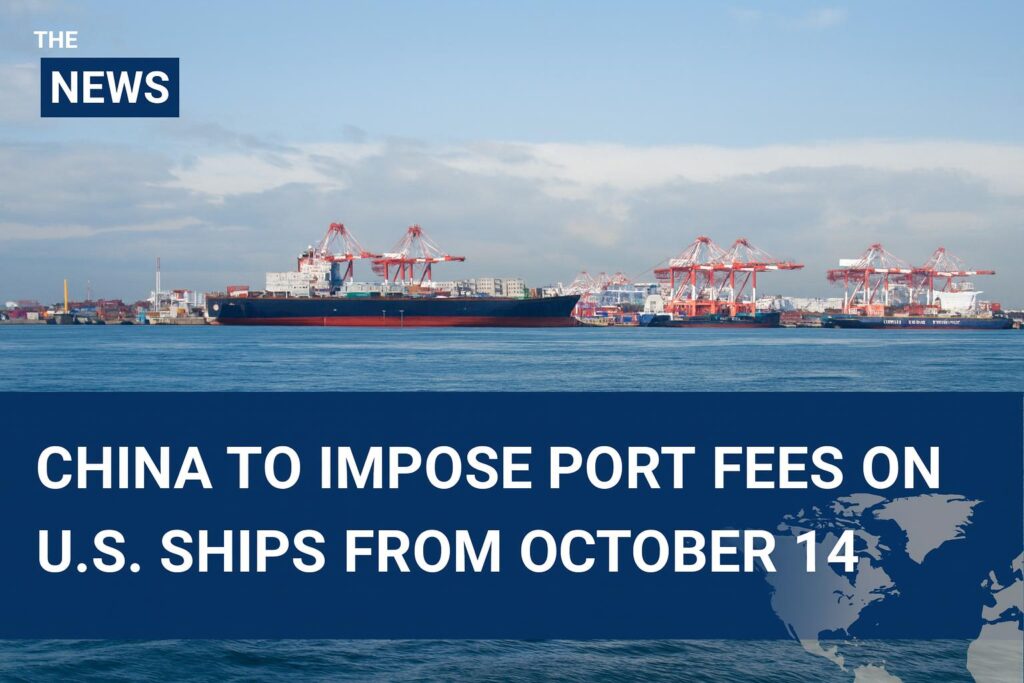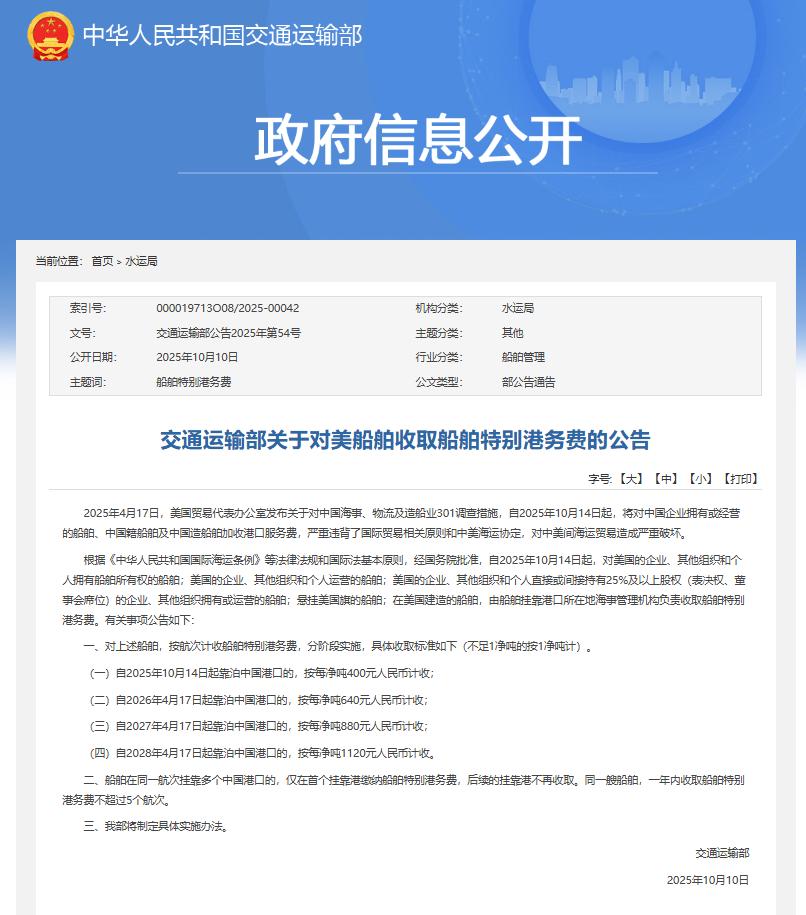China to Impose Special Port Fees on U.S. Vessels Starting October 14, as announced by China’s Ministry of Transport, marks a new phase in reciprocal maritime policy between China and the United States.
Starting October 14, 2025, U.S.-flagged and U.S.-owned vessels calling at Chinese ports will be required to pay special port fees calculated per net ton, with a maximum of five voyages per year for each vessel.
The ministry stated that this decision aligns with international trade principles and directly coincides with Washington’s plans to start imposing port fees on Chinese ships on the same day.
Analysts believe this reciprocal port fee framework could reshape operational costs for shipping companies and influence trade and freight rates between Asia and North America.

Background: U.S. Port Fee Measures Spark Reciprocal Action
In April 2025, the United States Trade Representative (USTR) announced a new policy imposing port fees on Chinese vessels calling at American ports.
Under this plan, the U.S. government will charge Chinese-flagged, Chinese-built, or Chinese-operated vessels based on their net tonnage or containers handled per voyage.
Washington described the move as an effort to promote “fair competition,” but shipping analysts viewed it as a policy that explicitly targets vessels owned or operated by Chinese companies.
The framework, established under the Section 301 investigation, authorized the U.S. port fees to take effect October 14, 2025, the same day China’s Ministry of Transport begins charging special port fees on American vessels.
According to the ministry of transport, the policy is a balanced response designed to immediately correct cost asymmetry and protect the legitimate interests of China’s shipping sector.
Officials emphasized that this is not an escalation but a measured trade measure consistent with international economic norms.
Rate Schedule and Calculation of Special Port Fees
The newly introduced special port fees apply to U.S.-flagged, U.S.-built, and vessels owned or operated by American entities.
Charges are calculated per net ton, following this progressive schedule:
| Year | Fee per Net Ton | Notes |
|---|---|---|
| 2025 | 400 yuan (~US$56) | Initial implementation |
| 2026 | 640 yuan (~US$90) | First adjustment |
| 2028 | 1,120 yuan (~US$157) | Final rate under current plan |
Each same vessel will be charged for a maximum of five voyages per year, regardless of route.
If a ship calls at multiple Chinese ports during the same voyage, the fee applies only once at the first port of entry.
According to the Ministry of Transport, the special port fees will fund port infrastructure upgrades, safety improvements, and related equipment for China’s maritime industry.
Comparison: China vs. United States Port Fee Policies
The following table highlights the structural similarities between China’s special port fees and the U.S. port fees on Chinese ships, showing a mirrored implementation approach.
| Category | China: Special Port Fees on U.S. Vessels | United States: Port Fees on Chinese Ships |
|---|---|---|
| Effective Date | October 14, 2025 | October 14, 2025 |
| Authority | China’s Ministry of Transport | U.S. Trade Representative (USTR) |
| Fee Basis | 400 yuan per net ton (rising to 1,120 yuan by 2028) | $56 per net ton, adjusted annually |
| Coverage | U.S.-flagged, U.S.-built, and vessels owned or operated by U.S. companies | Chinese-flagged, Chinese-built, or vessels owned or operated by Chinese companies |
| Maximum Charge Frequency | Five voyages per vessel per year | Five voyages per vessel per year |
| Multi-Port Rule | Applies once at the first Chinese port of entry | Applies once at the first U.S. port of entry |
| Purpose of Fees | Support port infrastructure and maritime safety | Ensure fair cost distribution and competitive balance |
| Legal Reference | Ministry of Transport Announcement, Oct 10, 2025 | USTR Section 301 Framework, Apr 2025 |

Impact on Trans-Pacific Shipping Companies
For shipping companies managing U.S. ships or vessels owned or operated under joint ventures, the special port fees may slightly increase voyage costs.
According to shipping data provider Alphaliner, North America accounts for about 18% of China’s shipping industry container throughput — making these fees an important cost consideration.
Analysts predict that the net ton fee is modest but could influence voyage planning, port selection, and freight rates on major trans-Pacific routes.
Operators may consolidate calls at fewer Chinese ports to avoid multiple charges under the maximum of five voyages rule.
Industry observers also note that Chinese vessels calling at U.S. ports will face comparable charges, reflecting Washington’s reciprocal measures and aligning with similar port fee frameworks emerging in South Korea and Japan’s maritime markets.
Expert Analysis and Industry Reactions
Experts at consulting firm Reddal describe the decision as “a meaningful figure symbolically, yet economically manageable.”
Freight rate adjustments, they said, will likely be contained within quarterly pricing cycles.
Shipping experts also note that vessels berthing at multiple Chinese ports or under Chinese-owned operators will not face repeated charges for the same voyage, reinforcing fair maritime trade practices.The ministry of transport said the fees will help modernize China’s shipping industry while adhering to international trade principles.
According to reports by Reuters and China Daily, both governments are expected to review the port fee systems in 2026 to ensure compliance with international economic standards and legitimate rights of shipping companies.
The following content may also interest you:
- Shipping Cost from China to the USA
- Air Freight from China to the USA
- DDP Shipping from China to USA
- How Long does it Take to Ship from China to USA
- 20FT & 40FT Container Shipping Rates from China to USA
Future Outlook: Freight Rate Adjustments and Maritime Trade
Industry observers consider the move reciprocal yet stabilizing, aimed at maintaining parity in global maritime trade rather than escalating tensions.
Although special port fees may marginally affect short-term freight rates, the impact on long-term maritime logistics remains limited.
Analysts further suggest that the introduction of port fees on both Chinese and U.S. vessels reflects a broader initiative to balance operational costs across the global shipping fleet.
This reciprocal framework may help foster more predictable cost-sharing and stabilize pricing structures along major international shipping routes.
FAQ: China’s Special Port Fees on U.S. Vessels
What are the special port fees per net ton and when do they start?
Starting October 14, 2025, China will charge 400 yuan per net ton, rising to 640 yuan in 2026 and 1,120 yuan in 2028.
How many times can the same vessel be charged each year?
Each vessel will be charged for a maximum of five voyages per year, regardless of route.
Do the fees apply at every Chinese port on the same voyage?
No. Ships calling at multiple Chinese ports during the same voyage pay once at the first port of entry.
Which ships are covered by the policy?
The regulation applies to U.S.-flagged, U.S.-built, and U.S.-owned or operated vessels, including those under American companies or individuals.
Are these fees connected to U.S. port fees on Chinese ships?
Yes. Both nations start charging port fees on October 14, 2025, under reciprocal maritime policies.


